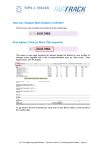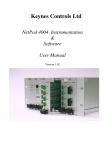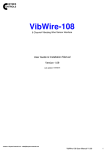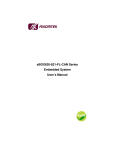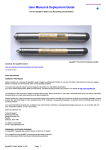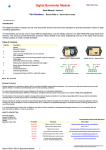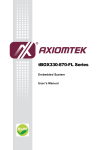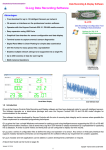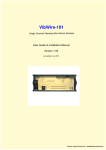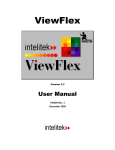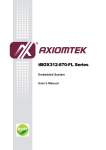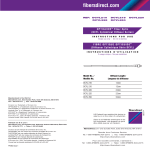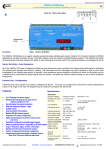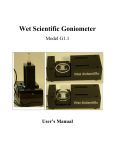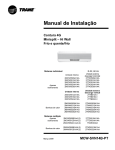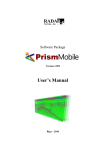Download user manual here
Transcript
Geotechnical Instrumentation In-Place-Inclinometer User Manual SDI-12/RS485 Digital Network Device Advantages The In-place Inclinometer (IPI) is ideally suited for near real-time measurement of lateral displacement of rock, soil and man made structures. Sensor strings can give a complete profile of vertical or horizontal displacements. Available in Uni-Axial and Bi-Axial sensor versions. Low Power SDI-12 or RS-485 digital communications. IP68 rated in-line network connection for fast installation & maintenance. Ideal for multiple sensor applications with limited tube space. Programmable averaging period for signal enhancement and noise reduction Digital data communication to remove noise and simplify installation. Ideal for monitoring the stability of natural and cut slopes, tunnels, embankments and structural foundations for large structures. Immersion Proof to 80 m In-Place-Inclinometer In-Place Inclinometers are typically used for monitoring subsurface deformations around excavations when rapid monitoring is required or when instrumented locations are difficult to access for continued manual readings. The sensors are computer driven, gravity-sensing transducers joined in a string by articulated rods, or mounted and they can be installed equidistantly in the casing or concentrated in zones of expected movement. With the in-place instrument, as many as 36 sensors are mounted in the casing and left semi-permanently in place. The sensors are easy to install and maintain using the in-line digital network for all measurement operations. A single 3 core cable is all that is required to communicate to the sensor chain. Compared with conventional instruments, the in-place inclinometer hardware is in-expensive and simple to use. A complete sensor chain cab be removed and deployed into a new location in most cases with little or no experience. Signals from the different In-Place inclinometers can be stored into a data logger and access remotely via the Internet, or in real time directly to a PC for local observation by construction/maintenance staff. This product is integrated into the Q-LOG free data acquisition and display software package. Last updated 21/11/2012 I-P-I User Mnaual V4 Jan 2013 1 Purpose of Monitoring If the different parts of a structure should move uniformly by even large amounts, considerable damage could occur. Structures affected by construction, or ground effected by a shift in water flow react by exhibiting movement. This movement is the principal cause of construction related damages because the affected structure may be subjected to forces it was not designed for. A building, for example, whose footings are settling on one side while the other side settles less or not at all will suffer tilting of some walls structures. The change in the water table may cause movement of an embankment leading to a slip. The Keynes Controls In-place-inclinometers have been designed to measure and report this type of structural movement. Q-LOG Application Software Download free at: http://www.aquabat.net/downloads/QlogSetupv1207.zip Features Quick User Guide Advanced rugged sensor technology utilising power management. Lightning Protects as standard In-line coupling for signal cable installation. Simplifies installation and maintenance. Calibrated range ±15 ±10 ±5 Deg Programmable Sample Period :- removes unwanted vibration Waterproof to 200 m. Sensor strings can provide a complete profile of vertical and horizontal displacements. Digital data communications to minimise noise The Keynes Controls range of inclinometers are intelligent devices and transmit data directly across the RS-485 or SDI-12 digital network. The guide is not meant as a teaching aid and some prior knowledge of using these two networks is expected. SDI-12 Sensor Unless specified at the time of order a single sensor is set to use ID=0. If the sensors are supplied as part of a kit then they will be pre-set to unique network ID numbers. Connect the sensor to any suitable data logger or PC supporting the SDI-12 network and issue the following commands. Command: 0An! sets the sensor ID from 0 to ID = n 0A3! new ID=3 0M! start measurement 0D0! Get Data Data will be returned. If using a Keynes Controls media converter then the status LED’s will illuminate. Calibration RS-485 Sensor Simple Command Structure Unless specified at the time of order a single sensor is set to use ID=0. If the sensors are supplied as part of a kit then they will be pre-set to unique network ID numbers. This version of the sensor requires a break character to be sent with the instruction. The break character is identified in the manual as the % symbol. All of the I-P-I models use the same command structure. Connect the sensor to any suitable data logger or PC supporting the RS-485 network and issue the following commands. aM! – starts a measurement aC! – starts a concurrent measurement aD0! – gets data from the sensor Command: %0An! sets the sensor ID from 0 to ID = n 0A3! new ID=3 %0M! start measurement 0D0! Get Data All sensors are calibrated at the Keynes Controls facility in the UK. External calibration can be undertaken upon request. Data will be returned. If using a Keynes Controls media converter then the status LED’s will illuminate. where a = Instrument ID Number The Q-LOG software automatically inserts the correct break character when identifying the network being used for communications. I-P-I User Mnaual V4 Jan 2013 2 Guide Wheel Mounting Bracket Sensor Components - Vertical I-P-I Digital Sensors In-place-inclinometers can be installed as a single sensor or as a chain of sensors making up a string of a set length. An individual instrument typically consists of a body, wheel assembly and gauge tube. Sensor Bodies - The I-P-I contains either single axis or bi-axis sensors but physically look identical. Gauge-tubes - The gauge tubes are available in various dimensions and when fitted to the sensor bodies make inclinometers from 1 through to 3 metres in length. Default Output Values - The Keynes Controls in-place-inclinometers default data type output is in mm/m. Sensor Wheels - Are used to link the different sensors together. The sensor wheel attaches to the bottom of the sensor body and uses this wheel as a guide in the casing. Warranty Information The information in this document is subject to change without notice. Keynes Controls Ltd . has made a reasonable effort to be sure that the information contained herein is current and accurate as of the date of publication. Keynes Controls Ltd. makes no warranty of any kind with regard to this material, including, but not limited to, its fitness for a particular application. Keynes Controls Ltd will not be liable for errors contained herein or for incidental or consequential damages in connection with the furnishing, performance, or use of this material. In no event shall Keynes Controls Ltd . be liable for any claim for direct, incidental, or consequential damages arising out of, or in connection with, the sale, manufacture, delivery, or use of any product. I-P-I User Mnaual V4 Jan 2013 3 WHAT WE PROVIDE WARRANTY PROVISIONS Keynes Controls Ltd . warrants the I-P-I range of tilt sensors for one year from date of purchase by the end user against defects in materials and workmanship under normal operating conditions. To exercise this warranty contact Technical Support at the phone or e-mail address listed below for a return material authorization (RMA) and instructions. Complete warranty provisions are posted on our website at http://www.aquabat.net The information in this document is subject to change without notice. Keynes Controls Ltd. has made a reasonable effort to be sure that the information contained herein is current and accurate as of the date of publication. Keynes Controls Ltd. makes no warranty of any kind with regard to this material, including, but not limited to, its fitness for a particular application. Keynes Controls Ltd will not be liable for errors contained herein or for incidental or consequential damages in connection with the furnishing, performance, or use of this material. In no event shall Keynes Controls Ltd . be liable for any claim for direct, incidental, or consequential damages arising out of, or in connection with, the sale, manufacture, delivery, or use of any product. HOW TO CONTACT US Technical Support Keynes Controls Ltd Riseley Business Park Riseley Berkshire, RG7 1NW Tel: (0044) 118 327 6067 E-mail: [email protected] FIRMWARE & SOFTWARE UPGRADES The In-place-inclinometer is upgrade able. Contact Keynes Controls Ltd. for details. If you suspect that your In-place-inclinometer is malfunctioning or requires re-calibration and repair is required, you can help assure efficient servicing by following these guidelines: Part Number Description IPI-bar-1m 1m gauge bar for any IPI sensor IPI-bar-1m 2m gauge bar for any IPI model IPI-bar-1m 3m gauge bar for any IPI model IPI-case-cap Cap for I-P-I housing SDI-12 network IPI-D-15-SDI12 Dual Axis I-P-I Solid state - +/- 15 deg - SDI-12 Comms - sealed to 100 m IPI-D-75-SDI12 Dual Axis I-P-I Solid state - +/- 7.5 deg - SDI-12 Comms - sealed to 100 m IPI-D-25-SDI12 Dual Axis I-P-I Solid state - +/- 2.5 deg - SDI-12 Comms - sealed to 100 m IPI-S-15-SDI12 Single Axis I-P-I Solid state - +/- 15 deg - SDI-12 Comms - sealed 100 m IPI-S-75-SDI12 Single Axis I-P-I Solid state - +/- 7.5 deg - SDI-12 Comms - sealed 100 m IPI-S-25-SDI12 Single Axis I-P-I Solid state - +/- 2.5 deg - SDI-12 Comms - sealed 100 m RS-485 network IPI-D-15-485 Dual Axis I-P-I Solid state - +/- 15 deg - RS-485 Comms - sealed 100 m IPI-D-75-485 Dual Axis I-P-I Solid state - +/- 7.5 deg - RS-485 Comms - sealed 100 m IPI-D-25-485 Dual Axis I-P-I Solid state - +/- 2.5 deg - RS-485 Comms - sealed 100 m IPI-S-15-485 Single Axis I-P-I Solid state - +/- 15 deg - RS-485 Comms - sealed 100 m IPI-S-75-485 Single Axis I-P-I Solid state - +/- 7.5 deg - RS-485 Comms - sealed 100 m IPI-S-25-485 Single Axis I-P-I Solid state - +/- 2.5 deg - RS-485 Comms - sealed 100 m The information in this document is correct at the time of printing. Keynes Controls Ltd withhold the right to make changes without notice. Please contact Keynes Controls Ltd for the latest details regarding this product Copyright Keynes Controls Ltd © 2011 - 2013 I-P-I User Mnaual V4 Jan 2013 4 SENSORS SPECIFICATIONS Calibrated Range ± 15 , ± 7, ± 2.5 Deg Sensor Input 32 bit Resolution +/- 2 arc Seconds (+/- 0.01 mm/m) Sensor Accuracy ±0.05% Full Scale Repeatability ±0.01% Full Scale (Typical values only) Operating Temperature -20 to + 75 °C Linearity 0.2% Full Scale Digital Network Type SDI-12 - 3 wire RS-485 - 4 wire Minimum Casing Internal Diameter 56 mm Maximum Casing Internal Diameter 72 mm Length 230 mm Power Supply @ 12V DC (SDI-12) Typical values only Ingress Protection 12 mA Dual Axis - measurement period 0.3 mA Idle 16 mA Dual Axis - measurement period 2 mA Idle IP68 - rated 100 m - other ranges on request Housing Material 316 stainless steel Weight 560 g without cable Signal Output Digital engineering values Raw data using configuration commands All I-P-I models support standard and enhanced ID address modes. 0..9 A..Z 0 .. 100 m standard 0 .. 1 km standard Increased can be achieved depending on signal cable quality. This product has a firmware upgrade facility RS-485 Addressing Mode: Range: SDI-12 RS-485 Firmware Supported Commands Adjusting the Full Scale Range The inclinometer can have the full scale range adjusted to suit the monitoring application. Over a small range the sensor is considered to be linear. The range setting is undertaken in units of mm/m The factors shown below are the default factory settings for 15 deg sensor. Use command aXCAn,val Sets cal n to val n Field Default 0 1 2 X-axis Offset X-axis Range mm/m X-axis Scale 0 250 1 3 4 5 Y-axis Offset Y-axis Range mm/m Y-axis Scale 0 250 1 therefore to change change the X-axis sensor to operate over +/- 10 deg range use the command aXCA1 175! where 175 is in units mm/m a = sensor ID number Example ID string a13KEYNESCOINPINC001H001F004 aM! aMC! where a = ID number start measurement start measurement with CRC aC! concurrent measurement aCC! concurrent measurement with CRC aD0! variable list A B C D E 5 parameters returned for each measurement ?! Query address Find the sensor ID number for a sensor with ID = 8 is to have the X-axis set to operate over 10 deg range (175 mm/m). Command: 8XCA1 175! Setting the number of returned data values The order and number of measured data values from the inclinometer can be assigned: Command: aXRA=”A B C D E” results variables aXI n! Integration Period milli-Seconds where n is in ms temperature offset in hundredths of degrees n is integer in hundredths of a degree aXCT n! Range Settings 15 Deg 250 mm/m Deg 175 mm/m Deg 87 mm/m Tilt-X Tilt Y Tilt-X Tilt Y Temperature Units (mm/m) Units (mm/m) (Calibrated) (Calibrated) Deg C The calibrated results are those assigned using the command in ‘aXCAn’ above. 24 AWG Polyeurethene Covered 2 twisted pair (4 core) + foil shield 3 twisted pair (6 core) + foil seal Electrical Cable SDI-12 RS-485 A B C D E Example, return tilt angle data items only: 3XRA=”A B C D”! Example commands where a = instrument ID number The following example shows an I-P-I with ID number = 3 set to a measurement with integration period for all axis to 1000 ms (1 second). Any integration period can be used to reduce the effect of unwanted vibration on a measurement operation. Command: 3XI 1000! Example, Set the temperature sensor offset to + 0.25 deg above the normal reading for a sensor with ID = 7 Command: 7XCT 250! I-P-I User Mnaual V4 Jan 2013 5 Stand-Alone Data Recorder The image below shows a standard low cost data recording system for stand-lone applications. The I-P-I sensors will operate with any suitable 3rd party logger unit supporting SDI-12 or RS-485 digital communications. For low power applications the SDI-12 based sensors and recorder are the recommended option, and for large scale systems RS-485 network sensors are recommended. When operating with the AquaLOG data recorder shown in the image below, the sensors are powered off between readings and are only activated when required to take a measurement.. Expansion Options The AquaLOG data recorder shown opposite can be expanded to accept up to a maximum of 36 I-P-I sensors or other intelligent SDI-12 based devices. Any suitable sensor from 3rd party suppliers can be used so long as it supports the correct digital network. . Support Assembly & Protective Cap SENSOR 1 X AXIS 1.086 MM/M Y AXIS 2.456 MM/M Inclinometer Casing Guide Casing Wheel assembly with universal joint Direction of movement Spacer Tubing Guide Wheel Slot Bottom Cap I-P-I User Mnaual V4 Jan 2013 Spacer Tube 6 Lightning Protection Scheme All of the Keynes Controls tilt sensors contain integral lightning protection using a gas discharge protection making them safe from anything but a direct strike. For the lightning protection to work the sensor earth has to be connected to a good ground connection. All the instrumentation inside the junction box should be connected to the main chassis earth. The main chassis earth connects all the sensor cable sheaths to earth. Wall If a metal instrument box is used then a good quality, thick single core cable should connect the ground spike to the box. Only a single earth point should be inserted into the ground to ensure no ground potentials cause errors to the input signals. Earth 1 5 2 4 3 Instrument Box Tilt Sensor Main Chassis Earth tab Instrument cable Ground Spike Temperature Compensation Although the temperature effects on the tilt sensor is tiny, and the results are automatically compensated for in the measurement operation. When there is considerable temperature changes on the sensor then the effect can be seen in results and the effect can be miss-interpreted as a physical movement. In this case recording the temperature values as part of the tilt measurement operation is essential in order to detect this possible source of error. It is good practice to record the sensor temperature data values as part of the logging program. Troubleshooting Maintenance and troubleshooting is reserved to periodically checking the sensor and cabling for damage. For sensors deployed outside for long term deployments then the cable entry ports should be examined for corrosion that may cause the signal cable to fail. The sensors are fully sealed units with no User serviceable parts. Sensor Readings are unstable: If there is a source of electrical noise nearby the sensor then the reading may be unstable. The source of noise can be motors, generators or antennas. To minimise the noise effects ensure that the earth cable is attached to the sensor and terminated to a suitable ground point. The earth cable is attached to pin-6 of the cable port. Noise Reduction All of the I-P-I ranges of sensors have a User programmable recording period in steps of 1 ms. This has the effect of removing background vibration and enhancing the correct tilt value. The unwanted noise is averaged out I-P-I User Mnaual V4 Jan 2013 7 L sin The In-place-inclinometer is intelligent and provides results directly in engineering units. The most common unit used with this sensor is mm/m (milli-meters / metre). The image opposite shows the in-place-inclinometer deployed on a vertical chain and the movement has been exaggerated to make clear the expected movement that can be detected. L sin th ng Le Understanding the Results L The total movement, from the top to the bottom of the chain and in a specified direction is the sum of the displacements from each sensor in that direction. = The vertical I-P-I chain are typically deployed in a casing as shown in the bottom image on page 6. True Vertical Distance between successive readings All the sensors have to be deployed in the same mechanical orientation for the results to be meaning full. Failure to mechanically align the sensors will cause errors in the total movement calculation. In practice the individual inclinometers are deployed equally spaced along the I-P-I chain. There is a choice of spacer bars that fix the sensors to specified points in the casing depending upon the sensor chain length and the required number of monitoring points. Tilt Angle Vertical I-P-I Chain Dual Axis Sensor Polarity -Y -Y +X AXIS -X +X -X The adjacent Image shows the polarity of the sensor output readings from the dual axis Inclinometer. +Y +Y Single Axis Sensor Polarity Dual-Axis Sensor Polarity The adjacent image shows the polarity of the sensor output readings from the dual axis Inclinometer. +X AXIS -X Signal Connection A glass seal is built into the top and bottom of the sensors This seal isolates the signals from the cables to the electronics mounted inside the sensor case. The pins are gold plated and so are protected from corrosion. Single-Axis Sensor Polarity The glass seal is rated to 80 m water depth. Displacement Calculation Pin-1 All of the In-place-inclinometer models provide data values in engineering units of mm/m. To convert the output value to displacement in mm Displacement (mm) = Sensor Output (mm/m) * Spacer length (m) Example View looking in cable port A sensor supplying 12.23 mm/m output value is mounted on a 3 m spacer bar then the Full systems detail & prices can be found at http://www.aquabat.net Last Updated: Nov 2011 I-P-I User Mnaual V4 Jan 2013 8 In-Place-Inclinometer Chain Installation The following instructions should be followed to assemble an I-P-I chain. The instructions are the same for both the SDI-12 and RS-485 version of the sensors. Overview 1. Layout the sensors in the order of installation. When purchased as a complete kit the individual sensors are individually labelled with their network ID number. It is good practice to install the instruments onto the I-P-I chain in order of the ID number, so instrument with ID = 0 goes to the top of the chain and the sensor with the highest ID number is installed at the bottom of the chain. 2. Insert the first sensor into the slots of the gauge casing making sure the wheels are correctly aligned. Ensure that the sensor signal cable is secured to the gauge rod using a cable tie or tape and that the cable passes clear of the sensor body as it passes down the tube. Clamp the top of the I-P-I sensor to the top of the gauge tube while preparing the next sensor in the chain. 3. Align the next sensor in the chain and connect the signal cables together using the waterproof connectors used as standard on this range of product. The connectors self align so the they cannot be wrongly terminated. 4. Repeat steps 2 and 3 for each sensor in the chain. 5. Connect the top wheel assembly and lower into place and lower the sensors into their final position. Secure the I-P-I string with the end cap. Note. Make sure there is slack cable around the joins to the cable does not influence or prevent the I-P-I string movement. Tools Vice grips for temporarily securing the I-P-I chain to the gauge casing. Allen Hex Key for securing the sensor body to the gauge rod. Cable ties for securing the signal cables to the gauge rods. Optional safety cable fastened to the bottom sensor to prevent the loss of the I-P-I chain. Data Averaging All of the Keynes Control model I-P-I sensors have the ability to define the averaging period ever which time a measurement is made. If the sensor is being deployed close to a source of local vibration, for example a railway track, then the effect of the unwanted vibration can be minimised and in some cases removed all together by USB-SDI12-Pro Media Converter Connections No. 1 - 4 SDI-12 Sensor Earth 6 1 Gnd / 0V N/A 5 2 +12V DC I-P-I Sensor Installation For 1 to 4 I-P-I sensors simply connect them directly to the USB-SDI12-Pro network bus. The USB-SDI12-Pro device powers the sensors directly from the USB port of the PC without any external power supply. Multiple I-P-I Sensors & Interface Installation SDI-12 Data 4 3 N/A When there are more than 4 I-P-I sensors or the total current drawn by the sensors attached to the network exceeds 100 mA then an external 12V DC power supply is to be connected as shown to the USB-SDI12-Pro media converter I-P-I User Mnaual V4 Jan 2013 9 1 Gnd 2 +12V DC Supply 4 Gnd Pin No +12V SDI-12 Bus To USB Port on a laptop or PC. SDI-12 Data External 12V DC Power Supply Connecting the I-P-I to a Data Logger The images below show how to connect the I-P-I to a data logger. The data logger shown is the AquaLOG unit and this uses the 3 wire SDI-12 port for data communications to the sensors. The main advantage for using the SDI-12 network is that is simple to install and to operate. The SDI-12 network powers the sensors attached to it for the duration of the measurement operation. The image below shows a single sensor connected to the logger unit. Additional sensors are daisy chained together with signal and network power supply all in common. When a measurement is being made the network port on the logger unit will power the sensor. SDI-12 Sensor Earth 6 1 Gnd / 0V N/A 5 2 +12V DC Battery Power Optimisation SDI-12 Data 4 3 N/A SDI-12 Port To optimise the battery life for a stand-alone logger system keep the number of recording operations to a minimum, and the averaging period over which the measurements are made as low as possible to give satisfactory results. The longer the sensor is powered on to make a measurement then the faster the battery supply will be used up. AquaLOG Data Logger Multiple Instruments Connected to a Data Logger The image below shows how multiple sensors are connected to the data logger. The expansion HUB can be connected together to increase the number of channels and to simply the installation and maintenance. Sensor ID=0 Sensor ID=1 Sensor ID=3 Sensor ID=2 Expansion HUB I-P-I User Mnaual V4 Jan 2013 10 Sensor ID=4 4.2 USB-RS485 Media Converter Wiring Diagram Fig 2 shows the signal connections required for connecting the PIEZOI-RM sensor to the RS-485 digital network. The USB-485 media converter fits into any USB port on a PC and uses the Q-LOG application software for data recording and configuration operations. The USB-RS-485 media converter shown below is a 3 pin device and requires a separate power supply to power the sensors. Make sure that the 0V on the media converter and the external power supply are connected together as shown in the diagram. View looking into cable gland port + RS485 RS-485 Sensor +485 GND –RS485 Earth 6 1 Gnd \ 0V N/A 5 2 +12V 4 3 RS-485 - Gnd View looking into media converter RS-485 + + RS485 –RS485 Gnd +12V View looking into media converter 4.1 USB-SDI-12 Media Converter Wiring Diagram SDI-12 Sensor SDI-12 Data Earth 6 1 Gnd / 0V N/A 5 2 +12V DC 4 3 N/A +12V DC Sensor Supply Sensor Connection Diagram The images below show the sensor connection details for both the SDI-12 and RS-485 model sensors. Expansion Block Expansion Block 1 2 3 4 RS-485 Sensor SDI-12 Sensor Earth 6 1 Gnd / 0V N/A 5 2 +12V DC SDI-12 Data 4 RS-485 - 4 RS-485 + Gnd 3 Gnd +12V DC 2 +12V DC N/A SDI-12 Data 1 3 N/A Earth 6 1 Gnd \ 0V N/A 5 2 4 3 RS-485 - RS-485 + View looking into cable gland port I-P-I User Mnaual V4 Jan 2013 11 +12V Fixture Structure - PC Data Acquisition System For applications on large structures such as a building or bridges, and where different types of sensor are to be used to create a complete monitoring system then the RS-485 network type instruments are best used. RS-485 version instruments enable sensor installations up to 1 km away for the data recording system to be used. The inclinometers can be mixed with any other suitable sensor along the network string. Up to a maximum of 36 sensors can be deployed Network Expansion Additional sensors can be added to the PC / Laptop data acquisition system by simply installing additional media converter and wiring the sensors to the network. SDI-12 Network - 0 - 100 m with up to 36 I-P-I sensors RS-485 Network - 0 - 1000 m with up to 36 I-P-I sensors Connects to USB Port on PC / Laptop USB-Media Converter USB-Media Converter Product Part Numbers Description SDI-12 USB Dongle SDI-12 USBPro Model Battery Powered Handheld SDI-12 Dongle AquaLOG Data Logger Digital Barometer 6 Port Expansion Block I-P-I User Mnaual V4 Jan 2013 Part Number USBS12v1 USB-SDI12-Pro SDI12-HB Aqualog Barom-SDI12 HUB-SDI12-6 12 Lightning Protection All of the I-P-I ranges of sensors have lightning protection fitted on the power and data lines. Connecting In-Place-Inclinometer Sensors Together All of the In-place inclinometers come supplied with IP-68 rated mating interlocking connectors enabling the sensors to be quickly installed. Simply lock adjoining connectors together to increase the I-P-I string length. A multi-core plastic sheathed cable is used for signal transmission with any spare cores acting as the local earth to reduce voltage losses for long network length operations. The signal cables are terminated to the glass-metal seals fitted into the sensor to maintain water integrity. ID=0 IP-68 rated mating interlocking connectors for fast installation and maintenance operations. ID=1 Gauge length of each sensor is between adjacent pivot Points. I-P-I with gauge tube wheel assembly I-P-I User Mnaual V4 Jan 2013 13 Reference Position 3 m gauge length 2 m gauge length 1 m gauge length The image opposite shows the standard length of the I-P-I sensors and gauge rods that are used for the sensor chain. Direction of movement For the optimum results the casing should be installed with one set of grooves aligned into the expected direction of motion. The wheels are used to align the sensor inside the gauge tube. Vertical In-Place-Inclinometer The in-place-inclinometer sensor chain consists of a series of inclinometers and a gauge case. Generally the sensors are connected to a data recording device such as a stand-alone logger unit or laptop for storage and display of the inclinometer data The Keynes Controls Q-LOG software is a good companion to the I-P-I sensor chain and gives easy access to the data and sensor configurations. .The inclinometer casing provides easy access to the sub-surface movement, controls the orientation of the sensors, and moves with the surrounding landscape. In vertical installations the gauge tube is mounted into a bore hole, and this bore-hole passes vertically through the suspected zone of movement into stable ground. The stable end of the I-P-I chain typically acts as the reference point for any future measurement points. One set of groves in the casing is always aligned into the expected direction of movement of the ground. Casing In-fill around the casing tube. The sensor casing tube is secured into the bore hole using sand and grout which is tampered to fill in the excess space between the land under investigation and the casing. Any movement of the land is directly transmitted to the gauge casing and so to the sensors contained inside. The casing is secured to make sure there is no movement apart from that induced by the landscape under investigation. The sensors are intelligent and provide data values directly in engineering units of mm/m by default. The output value can be converted directly into displacement of mm by scaling the output value by the gauge rod length. Displacement = Output mm/m x Gauge Rod length (m). Stable Ground I-P-I User Mnaual V4 Jan 2013 14 Setting the Initial Zero Position Once the mounting bracket is attached to the structure then the In-place-inclinometer can be secured. Attach the inclinometer to the mounting bracket and adjust the sensor position until it is in the vertical position, or as close to the vertical as can be judged by the eye. This gives the sensor the maximum possible measurement range. The images below show the direction of movement to the sensor that should be undertaken to set the initial position. Once the inclinometer has been moved to its starting position fasten the 2 x 8 mm mounting bolts securely. Vertical Beam Horizontal Beam Setting the Datum measuring point Once the tilt sensor is installed and set to the zero position mechanically then it can be electronically set to zero absolutely in software. Setting the sensor to zero position gives the sensor the ability to measure the maximum amount of movement. The initial position of the sensor at the start of the measurement operation is known as the datum position. Any further movement from the datum position is the actual movement of the structure under investigation. The movement from the datum position is in absolute units making it easy to judge how much a structure under investigation has moved. It is best practice to store raw data and to post process any movement. Once the sensor is fixed into place then take a measurement from it manually. Both the AquaLOG data recorder and Q-LOG software have the facility to take and display a single reading. 1. Once the I-P-I is fixed into place take the first reading - this is the initial datum position Measurement from datum = Current Value - datum Q-LOG and the AquaLOG support this simple formula. I-P-I User Mnaual V4 Jan 2013 15 This is a simple formula in Q-LOG or in the logger. Mounting Bracket Dimensions - Installation 80 mm The diagram opposite is not to scale. 25 mm 25 mm 50 mm For optimum results the bracket has to be firmly attached the the structure under investigation using mounting bolts in all three holes. If the bracket is difficult to fit then ensure that the 2 outer mounting points are used to secure the base. BASE Mounting the Tilt Sensor Wall Locking Washer Flat Washer Mounting Bracket Flat Washer Zero Adjust Anchor Rod Tilt Sensor The aim when fixing the tilt sensor to a structure is to secure it so that only movement from the structure under investigation is measured, and not movement due to environmental effects on sensor. There are 2 parts to securing the sensor for successful measurement operations. A firm anchor for the mounting bracket to the structure under investigation, and secondly a solid mechanical fastening for the sensor to the bracket. To obtain the optimum measurement range, the tilt sensor is set to its zero point. The sensor zero point can be approximated by eye and can be accurately set using a spirit level. Starting - Datum Position All of the Keynes Controls tilt sensors are intelligent devices and have the ability to store the initial datum position. The datum position can then be used as a reference for the measurement of any future movement. - Tilt + The datum position is only suitable as reference point so long as the sensor is not mechanically adjusted. Maximum Measurement Angle from the centre is +/- 15 Deg 15 Deg The maximum angle that can be measured in a single axis is +/- 15 Deg. Securing the sensor to a floor The inclinometer is a very sensitive instrument and to achieve the optimum results the sensor has to be secured to the based as firmly as possible. The inclinometer should be secured to a pair of back to back mounting brackets. Tilt Angle I-P-I User Mnaual V4 Jan 2013 16 Complete In-place-inclinometer PC Based Data Acquisition System The image below shows a complete In-Place-Inclinometer chain that can be supplied by Keynes Controls Ltd. The complete kit of parts consists of: Q-Log applications software I-P-I sensors and spacer bars Sensor Casing End stop and support USB Media Converter End-stop PC Data Recorder The laptop operates as the data recorder and display unit and offers the simplest way of undertaking a monitoring system. The Q-LOG software is free to download from the web site. 0.5 m The I-P-I chain can be made to any length to suit most geotechnical applications. Simply set the number of sensors and spacer bars to obtain the desired sensor chain length. All of the sensors are daisy chained together to form a local network. The sensors are all supplied with waterproof self aligning connectors ensuring the sensors cannot be wired incorrectly. The sensor cables are set at the time of manufacture to match the spacer bar lengths so there is no over hang and to minimise space the cabling takes up in the tube casing. The cabling does not restrict the sensor movement as can be the case in traditional in-place-inclinometer sensor deployments. There is still plenty of space Sensor Kit length The In-place-inclinometers are deployed into a casing and separated by spacer bars to create a fixed interval between the measurement points. Complete I-P-I sensor with wheel assembly First sensor location The first sensor in the chain is suspended underneath the end stop support. It is recommended that the first spacer bar connecting the upper sensor to the end stop be kept as short as possible in order to detect the surface movement. The smallest spacer bar that is currently manufactured is 0.5 m in length. Uniformity of measurement To simplify the data analysis operations and to visualise the movement then it is recommended that the sensors are equally spaced along the sensor chain. The individual measurement nodes can be set between 0.5 to 3 m along the chain using the standard spacer bars. Additional spacer bars can be manufactured on demand. Maximum number of sensors The maximum number of sensors that can be directly connected to the PC is purely limited to the network type in used the the free USB ports I-P-I User Mnaual V4 Jan 2013 17 In-place Inclinometer Data Acquisition System The image below shows how simple a PC / Laptop computer data acquisition system can be put together using the Keynes Controls media converter unit and I-P-I range of sensors. All of the current inclinometers connect to a network and send values directly in engineering units into data recorders or PC / Lap top data logging systems. Tilt values in units of mm/m and temperature values units of Deg C, or Deg F are transmitted digitally across the network. Digital data transmission minimises noise and errors due to cabling losses and also has the advantage of fast installation and simple maintenance. Adding new sensors to a network is simplified as no new calibration factors have to added to or changed inside the software. Q-Log Application SDI-12 digital network Laptop / PC Computer USB Data Link All of the inclinometer range of sensors are fully integrated into the Q-Log Data Recording and display software. Q-log is available free of charge for up to 10 sensors. I-P-I Tilt Sensor SDI12-HB Media Converter The maximum number of sensors that can be used and distance they can be deployed from the data logger is dependent on the network being used. Media Converters A range of media converters are available from Keynes Controls such as the USB-SDI12-Pro version shown opposite. The USM-Model-Pro version media converters can power individual sensors or interfaces directly from the PC USB port without any use of an external power supply. Models SDI-12 Dongle installed in a Laptop. USB-SDI12-Pro USB-RS485-Pro SDI-12 Network This product supports SDI-12 1.3 operations The image above shows the basic type USB media converter installed into a laptop. Model USB-SDI12-Pro An external power supply is required to energise the sensors with this model of converter. I-P-I User Mnaual V4 Jan 2013 18 Operation in Q-LOG All of the I-P-I range of sensors are fully integrated into the Q-LOG application software. Refer to the Q-LOG user manual for full instructions in using the software. Once the sensors are installed and the media converter is connected to the PC then the Q-LOG software can be used to acquire data in real-time. The quick guide for gather data from the I-P-I sensors is: Media Converter Comm Port Number 1. Make sure the sensors are installed correctly and that the are connected to the digital network media converter in the pins on the device. 2. Install the USB media converter into the PC Identify the Comm Port used by the media converter as this number is required by the Q-LOG Configuration. In the Microsoft Windows operating system the details can be found using Control Panel - System Devices - hardware - Com Ports - The options in Control Panel vary slightly between the different versions of the operating system is use. Q-LOG Software The In-place-inclinometer is integrated into Q-LOG. This manual expects that Q-LOG has already been downloaded and is operational on the data logger PC. 3. Start Q-Log Software File - Configuration tab. The ‘Logging Configuration’ Window will appear. This example shows that the USB media converter is an SDI-12 model and is using Com Port 6 in the operating system. COM Port Selection List Sample Rate Enter the COM Port number identified in Device Manager List here. Select the Network Type Logging Configuration Window Data Log File Name & Storage Location The network type is printed on the label of the media converter Options: SDI-12/RS485 Configuration option 4. The Q-log software has the facility to scan the chosen network and automatically identify any sensors that are detected. - the software updates the table in the main Window for each sensor that has been detected Select File - Scan for devices SDI-12 / RS485 Network Selection Assign the network type used for communication between the sensors and the I-P-I using the options provided. Currently there are only 2 options, SDI-12 or RS-485. The type of network in use depends solely upon the type of media converter installed into the PC. Use only the Keynes Controls media converters when running Q-LOG software. I-P-I User Mnaual V4 Jan 2013 19 Q-LOG Main Window Selecting the Model Type There are only 2 models of I-P-I currently available and they are single or dual axis devices. Both sensor models have the ability to return local temperature data values along with the tilt angle. Select the type of sensor to be used from the ‘Configuration’ menu options. Q-Log will return the number correct number of parameters from the device. Device Identification String Preset into the sensor or interface Sensor Option Selection Enables different sensor options to be used. Assigns the start cell of the sensor data into the data table making up the log file. A .. IU - Excel spreadsheet format. Displaying Engineering Units The full details for the use of the Q-LOG software can be found at http://www.aquabat.net/QLOGFree/qlogv2.html Follow the link and download the manual. I-P-I Operation in Q-LOG The in-place-inclinometer is integrated into the Q-LOG software. The engineering units for the in-place-inclinometer that are displayed on the Q-LOG screens is simply entered into the table opposite as text. The sensors used to acquire the data have to be pre-configured to the correct engineering units before being entered into the units column. The data values from the inclinometer is typically in units of mm/m The example is going to insert engineering units for use with an AquaDAT with ID = 2 for channel 0. From the ‘Select Variable’ Window Select the ‘Units’ cell to be configured. Cell to be configured This cell can be edited and values deleted just like a cell in a spreadsheet. Type the new ‘Units’ title into the specified cell: In this example shows a dual channel I-P-I with ID = 1 starting at cell ‘E’ with units is set to ‘mm/m’ . Type ‘mm/m’ in the ‘Units’ adjacent to any tilt sensor value. Repeat the ‘Units’, ‘Titles’ update for all the required cells. The units that is inserted into the table will appear on the panel meter and chart plots. Press the ‘OK’ button to store the new units. I-P-I User Mnaual V4 Jan 2013 20 Contents Features 2 Calibration 2 Purpose of Monitoring 2 Quick User Guide 2 Q-LOG Application Software 2 Adjusting the Full Scale Range 5 Stand-Alone Data Recorder 6 Expansion Options 6 Lightning Protection Scheme 7 Temperature Compensation 7 Troubleshooting 7 Sensor Readings are unstable: 7 Noise Reduction 7 Understanding the Results 8 Dual Axis Sensor Polarity 8 Single Axis Sensor Polarity 8 In-Place-Inclinometer Chain Installation 9 Data Averaging 9 USB-SDI12-Pro Media Converter Connections 9 Connecting the I-P-I to a Data Logger 10 Battery Power Optimisation 10 Fixture Structure - PC Data Acquisition System 12 Product Part Numbers 12 Lightning Protection 12 Connecting In-Place-Inclinometer Sensors Together 13 Vertical In-Place-Inclinometer 14 Setting the Initial Zero Position 15 Setting the Datum measuring point 15 Securing the sensor to a floor 16 Mounting Bracket Dimensions - Installation 16 Mounting the Tilt Sensor 16 Starting - Datum Position 16 Complete In-place-inclinometer PC Based Data Acquisition System 17 Sensor Kit length 17 First sensor location 17 Uniformity of measurement 17 Maximum number of sensors 17 In-place Inclinometer Data Acquisition System 18 Media Converters 18 Operation in Q-LOG 19 Media Converter Comm Port Number 19 Q-LOG Software 19 SDI-12 / RS485 Network Selection 19 Displaying Engineering Units 20 I-P-I Operation in Q-LOG 20 Selecting the Model Type 20 I-P-I User Mnaual V4 Jan 2013 21





















